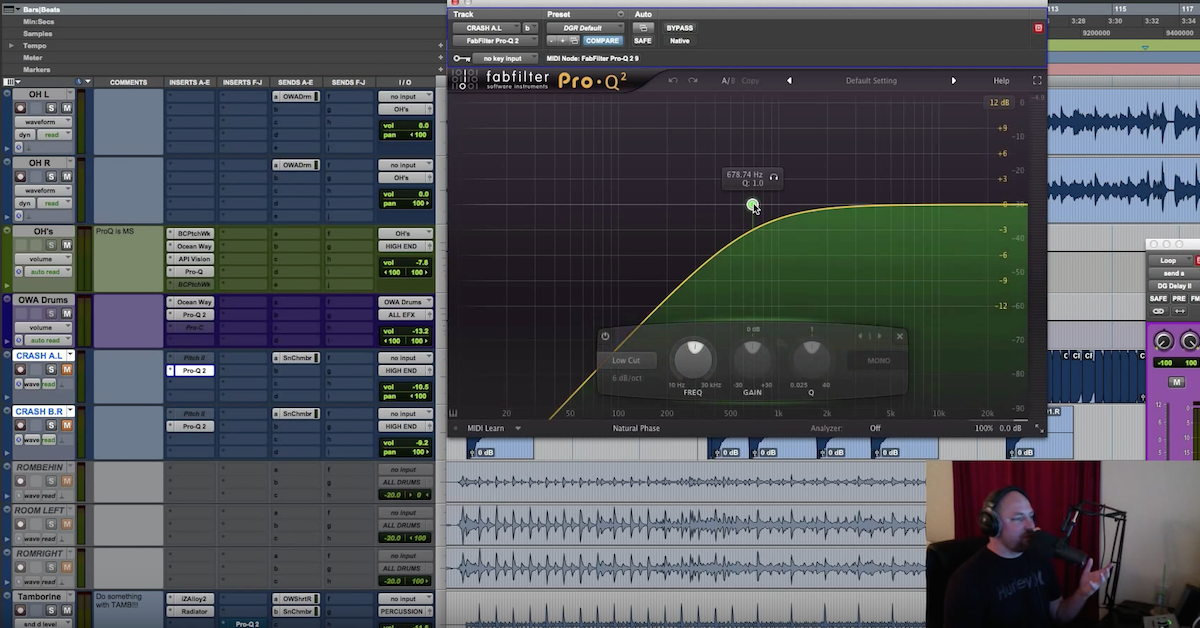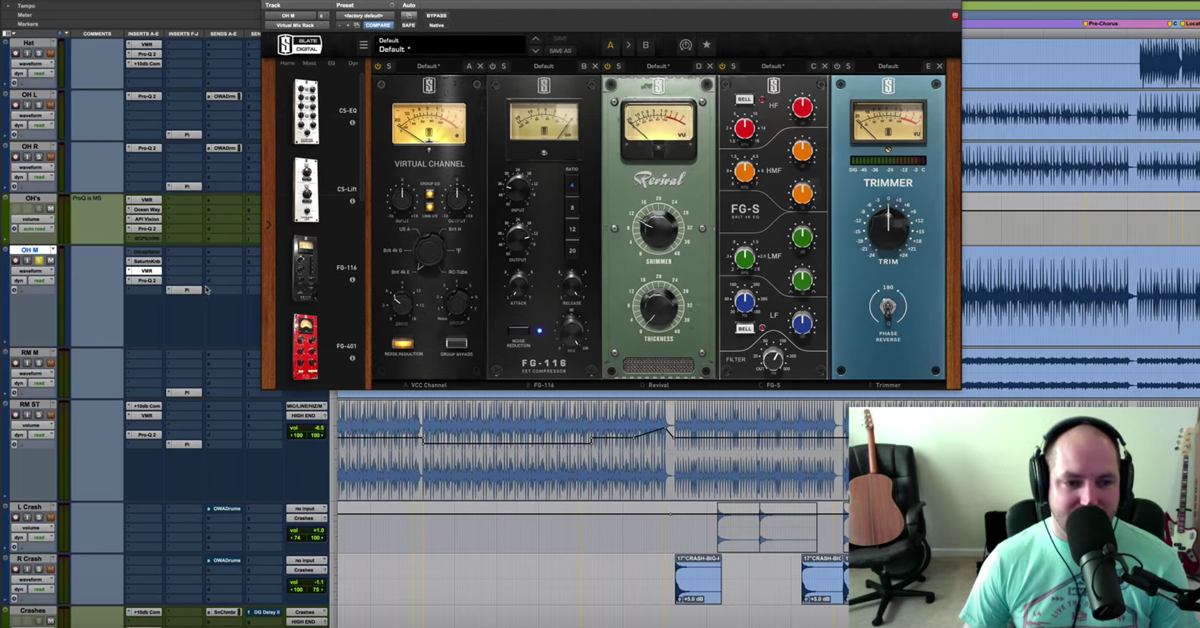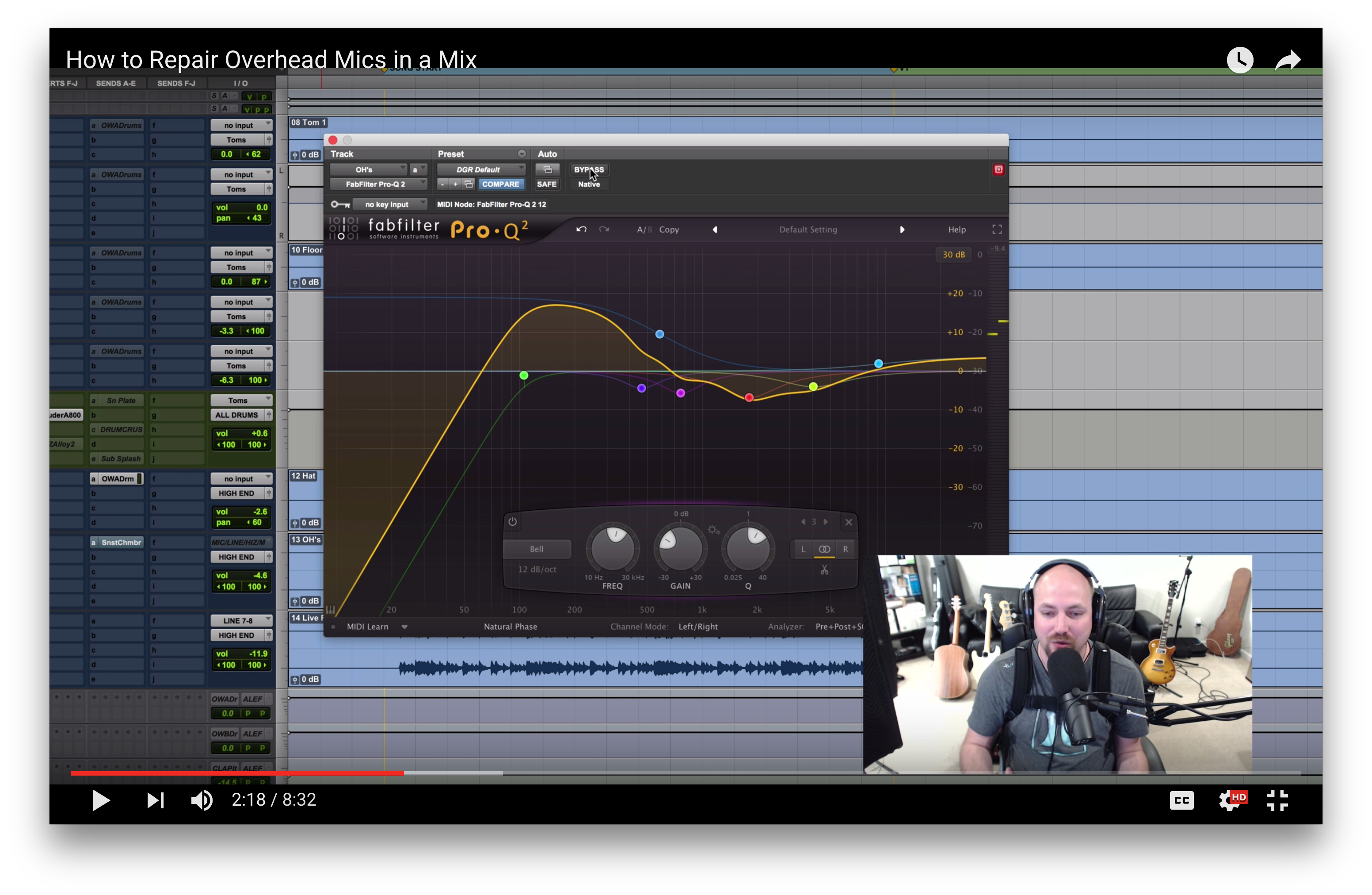Tips for Mixing Drum Overheads
Article Content
Drums are generally tricky to both record and mix. The trickiest part of this tricky instrument is the overheads. For me there’s a bit of procedure that doesn’t vary — I do the same thing essentially every time. Then there’s a bit that varies depending on exactly what’s happening in the context of the music.
First I listen to what’s there to determine what my overheads are bringing to the table. When I track overheads I’m usually trying to record the entire kit, but there are some tracking engineers who are really only looking to grab the cymbals. Just depends on the style of music and particular tastes of the band.
People who want an unrealistically close and clean sound will usually go primarily for the cymbals, whereas those who want a more natural sense of the drums will grab the whole kit. When we only want the cymbals, it may be worth high-passing the overheads to drop out the kick and body of the snare. I find a linear phase EQ is usually good for this process.
Then I check the mono fold. The hardest part of overheads is getting a sound that’s both wide and has a solid center. This means having a really solid phase relationship particularly in regards to the snare. Checking the mono fold and seeing how much of the snare and kick we lose can be pretty revealing.
If a lot disappears we may want to sacrifice a bit of stereo width in order to get a tight center. We can do this by tightening up the timing of the overheads, using the snare drum as our focus. For this, I can either zoom in on the waveform and simply line them up visually, or I can use a program like SoundRadix Auto-Align. Now, again, if we are using the overheads mainly for cymbals it’s not quite as important if the snare and kick have a focused center, in which case I may opt to leave the imaging as is.
On the subject of imaging and width it’s worth noting that sometimes the cymbals can mask the guitars if they have a wide stereo field. It’s a little counterintuitive but sometimes getting the widest sounding mix actually means pulling the drum overheads into the center a bit. Wide overheads also feel very forward, which can be great, but sometimes we want the drums (cymbals in particular) to sit a hair back in the front-to-back imaging.
For me, this creates a sense of depth and an overall bigger mix. Super wide, super close overheads usually makes me feel like I’m either listening to something artificial or I’m in a living room with the drummer. Stylistically this can definitely work sometimes, but I’d say 75% of the time I want something a little more live and deep.
Once the prep work is out of the way, I need to pull in the close captures in order to get a feel for what the overheads are really doing. Simply having the close mics in changes the balance of the kit which inevitably changes the perspective of the overheads. Additionally, the bleed from the close mics will interact with the overheads and shift the tone.
If there’s a large tonal shift, or it starts to sound too cluttered, or for whatever reason the close mics aren’t playing nice, I’ll use an expander to reduce the overall bleed. This isn’t really processing on the overheads per se, but it helps me figure out where the overheads are really sitting which influences whatever processing I’ll end up doing.
But wait, we’re still not onto the overheads yet. From this point, I actually treat the entire drum buss before getting into any individual captures. Again, this processing isn’t on the overheads, but if I add EQ or compression on the drum buss it will influence the sound of the overheads.
Compression
To compress overheads or not to compress overheads?
Like all things, it is case-dependent. If the cymbals or snare are coming through with a bit too much “stick”, I will use a limiter or transient designer to tame it down. Regardless of the style of music, there’s a quality of spikey stick sound that almost always sounds cheap to me, so I’ll take steps to reduce it.
The next thing I’m listening for is player dynamics. If the player is a little all over the map with how hard they’re hitting the drums, a bit of compression can help even things out. Be careful, very good players are very deliberate with their dynamics so this is really a judgement call. I find a touch of compression just to hold things together is beneficial, but for some players, I may need to be heavy-handed. In that case, I try to use a very colored compressor and make it seem like a “stylistic choice” rather than a crutch.
Lastly, if there wasn’t a room capture or if I just want more of the wash and sustain of the drums, I’ll use some compression for that. Usually if the drums are “bedding” the song rather than leaving a bunch of open space this is a cue to make it a little washy.
EQ
From there I start to fix tonal issues so if there’s any weird resonances from the room in the overheads, I’ll sculpt them out. Mind you, this is why we get our balances first. Cymbals have high pitched non-harmonic resonances — it’s how they work. Cymbals oftentimes sound bad in solo, but balanced with the kit appropriately.
It’s important to have context before carving out every aberrant tone otherwise the cymbal will end up sounding lifeless. It’s only if there’s an irritating resonance in the context of the complete capture that I attenuate it. Now, if the sound of the cymbals is a little hashy then I might roll off a little top end or if certain hits are just causing the microphone to over-sizzle I’ll use a de-esser to keep the very top end of the cymbals in check a little bit.
Often enough there will be some boxiness in the lower-mids (particularly if recorded in a small room) that might need some taming. Oddly enough, I almost always find myself using an API 560 to attenuate this. Sometimes the close captures need the lower-mid energy to feel full, so EQing the overheads alone may be better than the drum buss. Most of the time, if the cymbals need extra sparkle/top end I’m addressing this on the buss.
If the kick in the overheads is making the feel of the kick too boomy/washy, I may high-pass the overheads. I talked about this before but this is more in the sense of fixing an issue rather than making a stylistic choice. I’ll listen to how the kick and the overheads play with the close capture of the kick and if they aren’t getting along I’ll use a linear phase high-pass filter to tighten things up.
Then from here, some basic EQ to balance things. I usually like API-style EQs for overheads. There’s just something about their tone. If the overheads feel thin, a bump around 2k usually thickens things up (particularly for cymbals). If you have a ride cymbal or crash that’s really present, take out a little 1k mid-range to open the sound up.
Distortion/Saturation
Once its all cleaned up, then I might want to bring the color of the cymbals out. So for this we can use a Waves MV2. There’s a certain color to this I really like. Or if the cymbals are too tame for the style of music, the Renaissance Axx Compressor, which is originally intended for guitars, but has a nice bite to it. Lastly, FabFilter Saturn can be really great for overheads. In addition to distortion, it also has tone controls and dynamic controls and can function in multiband so you can get a lot of great character into your sound.
Once my overheads are sitting right, I tend to sculpt my room captures around the overheads. I like it when they kind of play together rather than sound like “hi, I’m a drum kit and here is my room.” So while I’m pretty conservative with processing on the overheads themselves, I tend to be pretty aggressive on the rooms — with my general aim to be getting the room tones to sit into the overheads.





